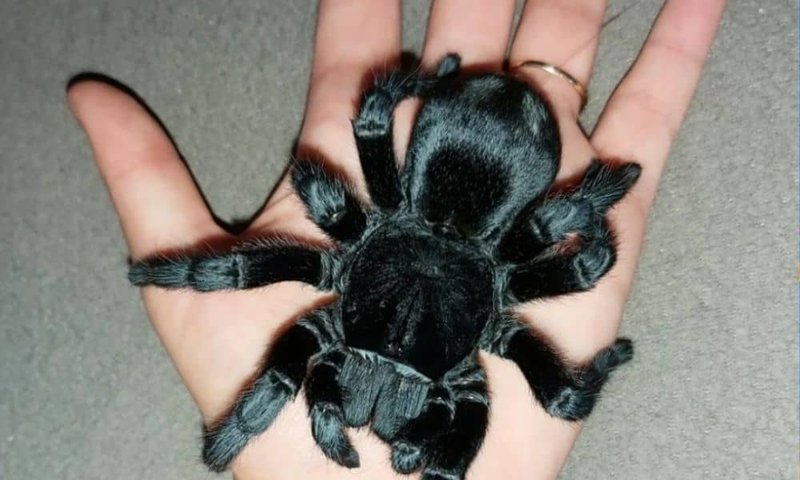
The Brazilian Black Tarantula, known scientifically as *Grammostola pulchra*, isn’t just a popular pet in the tarantula world; it’s also a subject of curiosity for many. These little guys come with some unique needs and behaviors that any potential owner should understand. Whether you’re a new pet owner or just fascinated by arachnids, we’ll break down everything you need to know about handling this captivating species safely.
Understanding the Brazilian Black Tarantula
Let’s start with the basics. This species hails from the lush forests of Brazil and is known for its striking appearance. With a body that can grow up to 5 inches in diameter and a shiny, velvety black exoskeleton, it’s hard not to be captivated. But don’t let that beautiful exterior fool you; they come with their own set of quirks and characteristics.
These tarantulas are primarily terrestrial, meaning they spend most of their time on the ground. Although they can sometimes be skittish, Brazilian Blacks are generally known for their calm demeanor, making them a popular choice for beginners. Here’s the thing: while they may not be as aggressive as other species, it’s essential to approach them with care and respect.
You’ll find that Brazilian Black Tarantulas are nocturnal creatures, primarily active at night. This means they might not be as lively during the day when you’re trying to get a good look at them. If you want to see their full beauty, consider observing them in the evening.
Is It Safe to Handle a Brazilian Black Tarantula?
Now, let’s get to the meat of the matter: is it safe to handle a Brazilian Black Tarantula? Honestly, the answer isn’t black and white. While many enthusiasts enjoy handling their tarantulas, it’s not without risks. Here are some things to keep in mind:
– Venomous Bite: Although the Brazilian Black’s bite isn’t considered deadly to humans, it can be painful. Their venom has a potency that varies from individual to individual. If you’re allergic or enjoy working with pets that don’t bite, it’s probably best to admire these beauties from a distance.
– Stress Factors: Handling can be stressful for your tarantula. They’re not like cats or dogs that enjoy cuddles; most tarantulas prefer to stay in their secure environments. If you do choose to handle your Brazilian Black, ensure that it’s calm and ready. A stressed tarantula might exhibit defensive behavior, like rearing up or trying to escape.
– Proper Technique: Handling tarantulas requires a bit of technique, which we’ll cover later. The key is to be gentle and supportive, so they feel secure in your hands. If you’re nervous, your tarantula may pick up on that energy.
How to Handle a Brazilian Black Tarantula Safely
If you’re determined to handle your Brazilian Black Tarantula, let’s go over some key steps for doing it safely. Here’s the breakdown:
1. Preparation: Before you even think about picking up your tarantula, ensure you’re in a calm, quiet environment. Clear away any distractions or disturbances that could startle your spider.
2. Choose the Right Time: Generally, handling should be kept to times when your tarantula is most active, usually in the evening. Check to see if it’s moving around or showing signs of being alert.
3. The Scoop Technique: When you’re ready to pick it up, use your hand as a scoop rather than grabbing. Slide your hand under the spider gently, ensuring it has something to hold onto. This technique helps the tarantula feel more secure and less likely to panic.
4. Keep it Low: Always hold your tarantula close to a flat surface. If it does decide to jump or slip, you want to minimize the fall. Think of it like holding a tiny puppy—you wouldn’t hold it high above the ground, right?
5. Don’t Force It: If your tarantula seems unwilling to come out, don’t force it. Let it crawl onto your hand in its own time. Remember, patience is key!
Common Myths About Handling Tarantulas
There are quite a few misconceptions when it comes to handling tarantulas. Let’s clear some of those up.
– Myth 1: All Tarantulas Are Dangerous: While it’s true that some can be aggressive, many species, including the Brazilian Black, are known for their docile nature. They don’t generally seek to attack unless they feel threatened.
– Myth 2: They Can’t Bond with Humans: Many people think tarantulas are entirely solitary creatures that can’t form a bond. While they may not show affection like dogs, they can become accustomed to their owners and recognize their presence.
– Myth 3: Handling Is Necessary: Some people think that regular handling is essential for a healthy pet tarantula. In reality, as long as it has a proper habitat and you maintain a good diet, your tarantula can thrive without being handled frequently.
Enriching Your Brazilian Black Tarantula’s Environment
If you plan to keep a Brazilian Black Tarantula, it’s essential to create an environment that keeps it active and engaged. Here are some tips for ensuring its habitat is comfortable:
– Tank Setup: A terrarium with proper ventilation is crucial. Aim for a 10-20 gallon tank with a secure lid. Include substrate, like coconut fiber or peat moss, to mimic their natural habitat.
– Temperature and Humidity: These tarantulas thrive in a temperature range of 75-85°F. Maintaining humidity levels around 60-70% will help keep your tarantula comfortable. A simple hygrometer can help track these levels.
– Hiding Spots: Include places for your tarantula to hide, like cork bark or small caves. It’s essential for their sense of security.
– Decor and Climbing Space: Brazilian Blacks are generally ground dwellers, but having some branches or decorations allows them to climb and explore.
Health Considerations for Your Tarantula
Taking care of your Brazilian Black Tarantula means keeping an eye on its health. Here are some important considerations:
– Feeding: These tarantulas eat primarily insects—crickets and mealworms are popular choices. Ensure you’re feeding them the right size of prey (about the size of the tarantula’s body) to avoid health issues.
– Signs of Stress or Illness: Watch for signs like lethargy, refusal to eat, or changes in behavior. If you notice any of these, it might be time to consult a vet who specializes in exotic pets.
– Molt Monitoring: Tarantulas molt periodically, shedding their exoskeleton to grow. This process can be stressful, so during this time, handle them less and provide a calm environment.
So, is handling the Brazilian Black Tarantula safe? It certainly can be, as long as you approach it with the right mindset and techniques. With its calm nature and stunning appearance, this tarantula can be a rewarding pet for those willing to learn. But remember, handling should be approached with caution, respect, and a genuine understanding of the creature you’re working with.
Before diving into the world of tarantulas, consider what type of relationship you want to have with your pet. If you prefer a creature to admire without too much hands-on interaction, that’s perfectly fine, too! The key is to educate yourself, prepare properly, and enjoy the fascinating journey of caring for your Brazilian Black Tarantula.

